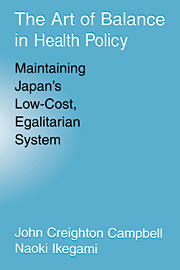Book contents
- Frontmatter
- Contents
- List of Tables and Figures
- Preface
- 1 Low Health-Care Spending in Japan
- 2 Actors, Arenas, and Agendas in Health Policy Making
- 3 Health-Care Providers
- 4 The Egalitarian Health Insurance System
- 5 The Macropolicy of Cost Containment
- 6 The Micropolicy of Cost Containment
- 7 The Quality Problem
- 8 Lessons?
- Index
6 - The Micropolicy of Cost Containment
Published online by Cambridge University Press: 07 October 2011
- Frontmatter
- Contents
- List of Tables and Figures
- Preface
- 1 Low Health-Care Spending in Japan
- 2 Actors, Arenas, and Agendas in Health Policy Making
- 3 Health-Care Providers
- 4 The Egalitarian Health Insurance System
- 5 The Macropolicy of Cost Containment
- 6 The Micropolicy of Cost Containment
- 7 The Quality Problem
- 8 Lessons?
- Index
Summary
A procedure for deciding overall health-care expenditures, as described in the previous chapter, is of little use unless the ceiling can be enforced. Fixed prices are the main mechanism for the implementation of government policy – primarily cost containment in recent years, but other goals as well. Of course, the fee schedule directly controls only prices, not volume, but it is supplemented by a variety of devices that effectively constrain the behavior of providers. Most important have been manipulations of relative prices, regulative directives, and a rather ad hoc system of claims review.
American dogma would hold that these methods should not be effective. It is argued that price controls and regulations cannot work because they do not control quantity, they lead to price distortion, and they result in a rebound when repealed. Moreover, many American experts believe that the appropriateness of care must be evaluated based on criteria from well-defined protocols, as defined by professional societies, or evidence from sophisticated databases produced by “outcomes research.”
Although these assumptions appear plausible, empirical evidence from the Japanese health-care system indicates that they are more myths based on ideological convictions than universally applicable rules. In Japan, a political mechanism for setting prices, regulative directives by the government, and ad hoc claims reviews have together worked effectively to hold down spending, especially since cost containment became the number-one policy objective in the 1980s.
- Type
- Chapter
- Information
- The Art of Balance in Health PolicyMaintaining Japan's Low-Cost, Egalitarian System, pp. 145 - 174Publisher: Cambridge University PressPrint publication year: 1998

